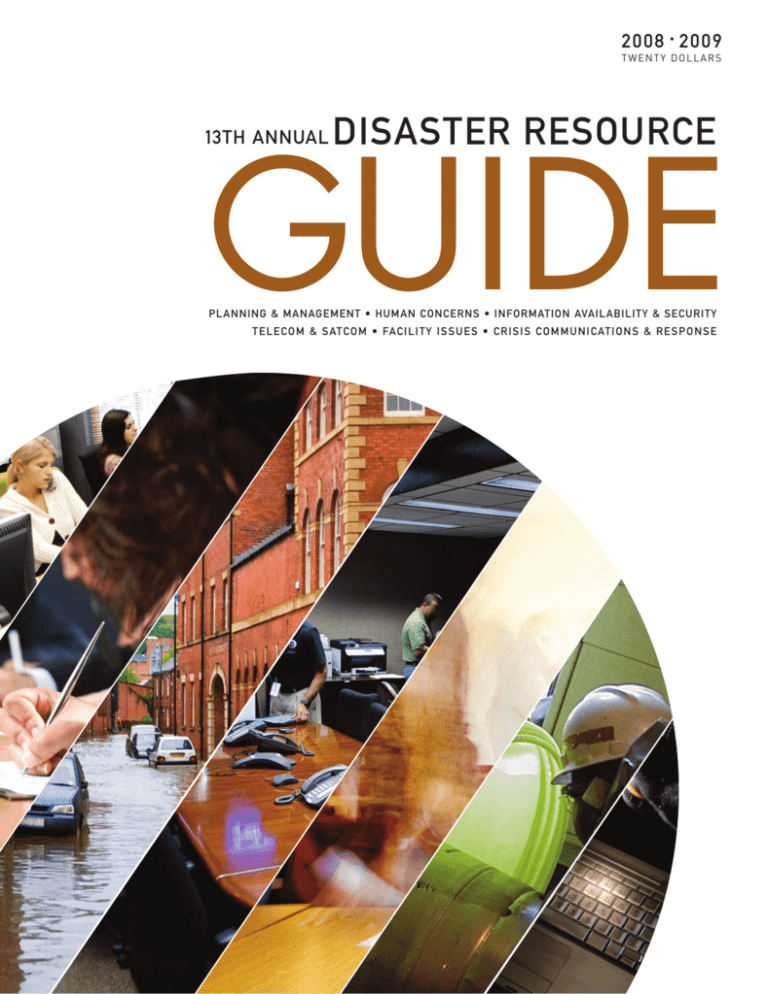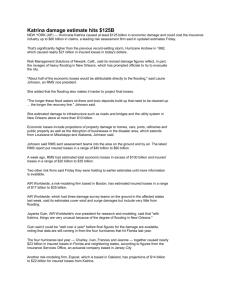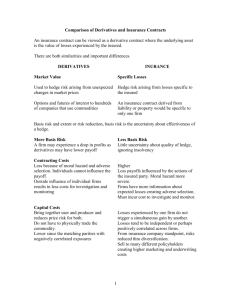DISASTER RESOURCE - Emergency Management & Safety Solutions
advertisement

2008 • 2009 Twenty DOLLARS GUIDE 13TH ANNUAL DISASTER RESOURCE PLANNING & MANAGEMENT • HUMAN CONCERNS • INFORMATION availability & Security T elecom & S atcom • FAC I L I T Y I S S U E S • C R I S I S C O M M U N I C AT I O N S & R E S P O N S E plan n i n g & m a n ag e m e n t Stormy Weather – Business Continuity & Climate Change By Regina phelps 46 DISASTER RESOURCE GUIDE 2 0 0 8 / 2 0 0 9 Climate change – it’s almost impossible to pick The city of Pisco in western Peru was almost totally destroyed, and 595 people were killed in this magnitude Annual Greenhouse Gas Emissions by Sector 8 earthquake. up a newspaper, magazine, or journal without seeing at least one article Residential, commercial, & other sources 4.8% Land use and biomass burning 10% Land use and biomass burning 6.6% Power Stations 21.3% Agricultural byproducts 40% Fossil fuel retrieval, processing, & distribution 29.6% Fossil fuel retrieval, processing, & distribution 11.3% Agricultural byproducts 12.5% Methane (18% of Total) Transportation Fuels 14% wouldn’t have been the case. Why the sudden Fossil fuel retrieval, processing, & distribution 8.4% change? Was it Al Gore? Transportation Fuels 1.5% Residential, commercial, & other sources 2.3% Land use and biomass burning 9.1% Industrial Processes 5.9% Land use and biomass burning 26% Residential, commercial, & other sources 12.9% venient Truth? Was it the 26% Power Stations 1.1% Power Stations 29.5% Was it the movie, An Incon- 9% Waste disposal & treatment 18.1% Industrial Processes 16.8% couple of years ago, this polar bear being designat- Waste disposal & treatment 3.4% Residential, commercial, & other sources 10.3% on the topic. Even just a Insured US$ 30b Agricultural byproducts 62% Transportation Fuels 19.2% Industrial Processes 20.6% Carbon Dioxide (72% of Total) Nitrous Oxide Percent worldw (9% of Total) ed a threatened species? The answer is that it was all of the above. Fact or Fiction? Overwhelmingly, the scientific community believes that climate change is upon us. Where the debate seems to have stalled is regarding the actual cause of this change. Natural planetary cycles? Man’s destructive impacts? Some combination of the two? Interesting though this debate may be, as continuity planners, we shouldn’t get “hung up” on the cause, we must focus our attention instead on the effects of climate change, and to develop plans to mitigate, prepare, respond, and recover. Definitions It is important to start with a few basic definitions. Climate change is simply the variation in the Earth’s global climate, or in regional climates over time. It involves changes in the average state of the atmosphere over time, ranging from decades to millions of years. Climate is impacted by the dynamic processes on Earth, external forces (including variations in sunlight intensity) and, more recently, by human activities. Greenhouse Gases (GHGs) are the components of the atmosphere that contribute to the greenhouse effect. GHGs are essential for our survival – without their effects, the Earth would be uninhabitable. In the absence of GHGs, the mean temperature of the earth would be about -19 °C. GHGs come from a variety of natural sources, and from human activity. In the order of relative abundance they include: water vapor, carbon dioxide, methane, nitrous oxide, and ozone. Number of natural catastrophes 1980–2007 1,000 800 An Increase in Natural Disasters Munich Re (the world’s second largest reinsurance company) reported that 2007 had the most natural disasters – 960 incidents – since it began keeping such records in 1974.¹ In 2006, it recorded 850 incidents. These natural disasters included earthquakes, tsunamis, windstorms, floods and extreme temperature events (e.g., heat waves, wildfires), mass movement (i.e., avalanches, landslides), and hurricanes. Overall losses exceeded $83 billion USD – that’s billion with a ‘B.’ Some of 600 400 200 the worst events are listed below: January 2007: Storm Kyrill This storm affected large parts of Northern and Western Europe. It produced hurricane-force winds, resulting in insured losses of about $5.8B USD, and total economic losses of approximately $10B USD. June – July 2007: Flooding in the UK Geophysical e Earthquake, v Widespread flooding occurred in Great Britain over a two-month period. It led to insured losses of about $3B USD, and total economic losses of $4B USD. Meteorologica Tropical storm July – November 2007: South Asia Flooding The floods that lasted over five months severe weathe created a huge amount of human suffering. Over 20 million people were tornado, local displaced. This resulted in well over 6,600 deaths and economic losses of $1B USD. October 2007: California Wildfires Hydrological e Storm surge, r flash flood, ma (landslide) Southern California is no stranger to disaster, particularly wildfires. The fires in the fall of 2007 caused the largest evacuation in the state’s history. Over 410,000 acres burned, and more than 2,100 structures were destroyed. The insured losses were at least $1.9B. continued on page 48 www.disaster-resource.com Climatologica 47 Freeze, wildla previous years. previous years. 5% 5% 8 earthquake. US$ 30bn 9% – Flood losses accounted for 26% of plan n i naccounted g & m a n ag m e noft – Flood losses fore26% the insured losses, which was far the insured losses, which was far above the long-term average of 7%. above thecontinued long-term average ofpage 7%. This was due to the two from floods in the 47 This was due to the two floods in the United Kingdom in June and July, United Kingdom in June and July, with a total insured loss of US$ 6bn. with a total insured loss of US$ 6bn. 40% 40% 50% 50% Percentage distribution Percentage distribution worldwide – At continental level, the loss impact worldwide – At continental level, the loss impact was most severe Number in Europe, where of natural catastrophes 1980–2007 was most severe in Europe, where Overall losses: US$ 82bn almost half of all insured losses 960 ss almost half of all insured Overall losses: US$ 82bn 960 events events losses 1,000 were incurred – roughly US$ 13bn. 8% were incurred – roughly9% US$ 13bn. 9% 8% It is also noticeable that9% Australia/ 9% 19% verall It is also noticeable that Australia/ 19% verall Natural Disasters 2007 accounted800for 7% of the geOceania of Oceania accounted for 7% of the ge of (US$ 1.8bn), which was much estlosses losses (US$ 1.8bn), which was much est higher than the average of the last 600 arthhigher than the average of the last arth10 years (1.5%). This was primarily erall 10 years (1.5%). This was primarily erall due to the hail events 400 in Canberra in 45% 45% due to the hail events in Canberra in February and Sydney in December 37% ost 37% in December ostFebruary and Sydney and to the windstorms and fl oods 200 e in in and to the windstorms and floods e that hit New South Wales in June. Percentage distribution Percentage distribution in June. -- that hit New South Wales worldwide 30. worldwide 0 30. 1980 1988 45% 45% Percentage distribution Percentage distribution worldwide worldwide 1992 16,000 16,000 fatalities fatalities tt to to 5% 5% 5% 5% of of ar ar 7%. 7%. n n the the uly, uly, 6bn. 6bn. pact pact ere ere 007 ss007 3bn. 3bn. ia/ ia/ e e much much ast ast arily arily rra rra in in ber ber ds ds ne. ne. 1984 28% 28% 40% 40% 1996 2000 Insured losses: Insured losses: US$ 30bn US$ 30bn 3% 9% 3% 9% 2004 3% 26% power companies away from plants that emit high levels of carbon dioxide and focus on new, cleaner and renewable technologies. (The principles do not, however, strictly prevent any of the banks from financing the plants.) 62% Percentage distribution worldwide Geophysical events Earthquake, volcanic eruption Meteorological events Tropical storm, winter storm, severe weather event, hail, tornado, local storms 7. Physical Hydrological events Storm surge, river flood, flash flood, mass movement (landslide) Climatological events Freeze, wildland fire, drought Ten-year mean Munich Re Topics Geo 2007 45 26% 26% 50% 50% 62% 62% Percentage distribution Percentage distribution worldwide worldwide Percentage distribution distribution Percentage worldwide worldwide Overall Overall losses: losses: US$ US$ 82bn 82bn 8% 8% Geophysical events Geophysical events 19% 19% Earthquake, volcanic eruption due to increased costs or lack of availWhat are the Effects of Climate Earthquake, volcanic eruption able raw materials? Change on Business? Meteorological events Meteorological events Tropical storm, winter storm, 28% storm, winter storm, 28% 3. Product and technology risks Climate change presents veryTropical different severe weather event, hail, severe weather event, hail, local storms problems than we normally tornado, face – in tornado, local storms Some companies will do better than Hydrological events others in a carbon-constrained world. many ways, it resembles an influenza 45% Hydrological events 45% Storm surge, river flood, Storm surge, river flood, Some will be able to minimize their risk pandemic. The three key effects include: Percentage distribution distribution flash flood, mass movement Percentage flash flood, mass movement worldwide worldwideis global – we (landslide) by creating “climate-friendly” products The impact will all go (landslide) Climatological events and services. This is already becoming a throughInsured this together; however, some Climatological events Insured losses: losses: Freeze, wildland fire, US$suffer 30bn Freeze, wildland fire, common theme in advertising and the US$ 30bn areas will more than others. drought 3% 9% 3%is long-termdrought 9% framing of products and services. The problem – it will Ten-year mean 1996 2000 2004 1996 not resolve 2000 2004 quickly, if ever. Ten-year mean 4. Litigation 45 Munich Re Topics Geo 2007 45 Munich Re Topics Geo 2007 The harm may be irreversible. Companies that create large amounts of 26% 26% GHGs will likely see litigation in the Seven Risks of Climate Change future reminiscent of asbestos, tobacco, 62% There are seven risks 62% to business associand even the fast-food industry. Percentage distribution Percentage distribution ated with climate change.² worldwide worldwide 1. Regulatory The impact is likely in two ways: Geophysical Geophysical events •There willevents be regulation on emissions Earthquake, Earthquake, volcanic volcanic eruption eruption of products (i.e., lawnmower or car Meteorological events events Meteorological emissions). Tropical Tropical storm, storm, winter winter storm, storm, severe severe weather weather event, event, hail, •Regulation on hail, the manufacturing tornado, local storms tornado, local storms process used to create products. 2. Hydrological events events Hydrological Storm surge, surge, river fl flood, ood, Supply chain Storm river flash ash fl flood, ood, mass mass movement movement fl (landslide) (landslide) Every company will need to assess their supply chain in relationship to climate Climatological Climatological events events change. Freeze, wildland wildland fi fire, re, Freeze, drought drought •Are any of your suppliers vulnerable mean toTen-year regulation? Ten-year mean 45 Munich will Re Topics Topics Geo 2007increased •What beGeo the cost to 45 Munich Re 2007 suppliers to comply with regulations? •Will your supplier network be unable to continue to supply you products 48 DISASTER RESOURCE GUIDE 2 0 0 8 / 2 0 0 9 5. Reputation Companies who do not embrace a more carbon-neutral business model will likely be judged in the court of public opinion. This will have impacts on consumer choices and investment opportunities. 6. Financial Three of the nation’s largest investment banks have developed new environmental standards to help lenders evaluate risks associated with investments in coal-fired power plants. Citibank, JP Morgan Chase, and Morgan Stanley issued “Carbon Principles” (February 4, 2008), making it more difficult for coal plants to secure financing. The focus of the principles will be to steer Continuity planners will have their work cut out for them when addressing the plethora of physical risks associated with climate change. •Flooding – 100-year floods happening more often •Droughts – for protracted periods of time and in larger areas, which will lead to an overall decrease in potable water in more places •Extreme heat – potential power outages and brown-outs •Extreme winter cold – natural gas shortages •Hurricanes, tornados, windstorms – more frequent, and stronger •Crop failures – impacting agricultural production •Decrease in fish populations •Famine – which destabilizes countries and regions, which increases population displacement, which causes widespread migrations, which lead to border tensions •Insect infestation •Increase in diseases and epidemics •Spread of “unusual illnesses” – such as ‘Chikungunya,’ a mosquito-borne disease which had previously been seen only in Asia and Africa, and is now being found in Europe, and malaria spreading into “non-malaria” locations •Rising sea levels across the globe, which will impact some of the largest cities in the world, including: Bangkok Guangzhou Hong Kong Kolkata (Calcutta), India London Miami Mumbai New York Shanghai Tianjin (China) Tokyo •National security – in a study released in April, 2007, climate change overall continued on page 50 plan n i n g & m a n ag e m e n t continued from page 48 is “perceived as a threat to national security,” by the U.S. Military Climate Change Strategies Quantify the company’s carbon footprint Before you can really develop a program to reduce GHGs, you need to know where your company currently stands. This involves understanding the source and level of GHGs, which will need to be tracked over time to get the whole picture, and also to be able to note improvements over time. This tracking and examination will likely lead to heightened awareness, with the possibility of cascading benefits to all involved. This process will expose broader risks and overall opportunities. Assess risks and opportunities What are the risks and opportunities to What we do as a profession best is to plan for those things that no one ever wants to happen. the business? Once you have a handle on your carbon footprint, you can begin to understand both the direct and indirect impact to your business. Now you have the opportunity to think strategically about the seven risks to your business. You have begun to explore what may hurt the business and what will provide opportunities to the business. Adaptive in response Armed with a good understanding of the big picture, adaptive response strategies can be developed, reviewed, and adopted. This is, of course, where emergency managers and BCP professionals excel, taking us back to the core aspects of our work: mitigation, preparedness, response, and recovery. •Mitigation – What can be done to minimize projected losses? This could include changing business locations for mission-critical processes, procuring new equipment, or adapting 50 DISASTER RESOURCE GUIDE 2 0 0 8 / 2 0 0 9 existing equipment to meet the new challenge. •Preparedness – What can be done to prepare staff and facilities? This includes developing plans and processes for new risks, educating and training staff, building awareness, and conducting exercises. •Response – Develop appropriate response plans based on findings and analysis. •Recovery – Reassess BCPs based on above. What needs to be changed or added to recovery plans to meet the new risks? What Does This Mean Going Forward? Climate change will be viewed as a significant risk going forward. How can emergency managers and BCP professionals stay ahead of the curve? Begin by reviewing your current risk assessment and hazard analysis for new risks or changes in existing risks. Then go back and look at your Business Impact Analysis (BIA) and note if any mission-critical functions have greater exposures or are at a heightened risk. Then assess each business continuity plan and your overall disaster recovery plan in view of your findings. Always go back to industry touchstones and ask yourself what can be done in the areas of mitigation, preparedness, response, and recovery to better position and protect the company. Now What? What we do as a profession best is to plan for those things that no one ever wants to happen. Emergency managers and Business Continuity professionals have a unique opportunity to be forward thinking regarding climate change. Don’t put your head in the sand and pretend it isn’t happening. Be bold, open, and innovative in your thinking and planning. About the Author Regina Phelps is an internationally recognized expert in the field of emergency management and contingency planning. With over 26 years of experience, she has provided consultation and speaking services to clients on four continents. She can be reached at regina@ems-solutionsinc.com. What can you personally do about climate change? •Understand the consequences of your daily choices. •Consider low-carbon products and a low-carbon lifestyle. •Consider low-carbon investments in your home: insulation, solar, etc. •Buy recycled products. •Practice the three R’s – Reduce, Reuse, Recycle. References ¹Münchener Rückversicherungs-Gesellschaft, 2008. ²Competitive Advantage on a Warming Planet, by Jonathan Lash and Fred Wellington, Harvard Business Review, March 2007.








